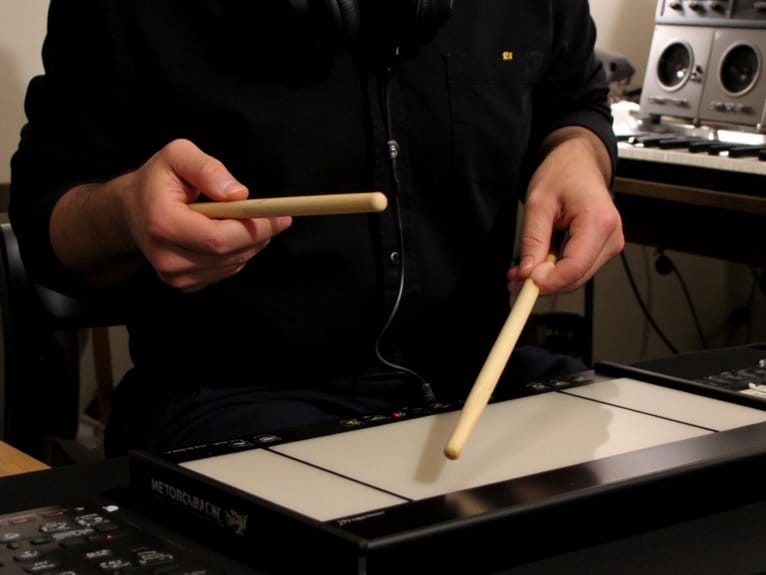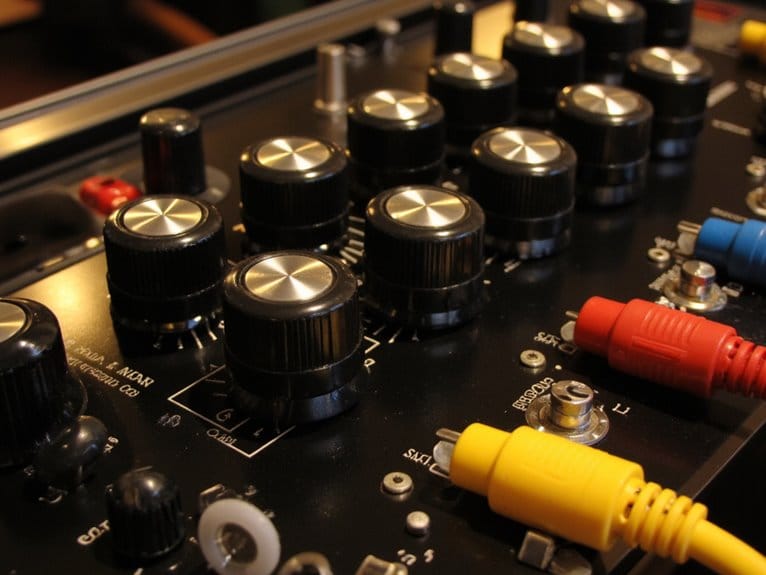Click Track Practice: Developing Internal Time
To develop solid internal time, you’ll need to gradually reduce your metronome dependence through strategic practice methods that build rhythmic anchors. Start by establishing dual physical cues like foot tapping and head nodding while vocalizing rhythmic sounds, then practice metronome reduction exercises where you halve the click speed while maintaining your playing pace. Strengthen limb independence by having one limb maintain steady pulse while others vary, and challenge yourself with intermittent metronome dropouts that force you to fill timing gaps internally, ultimately building the rhythmic freedom that separates confident performers from those still chained to clicks.
We are supported by our audience. When you purchase through links on our site, we may earn an affiliate commission, at no extra cost for you. Learn more.
Notable Insights
- Practice with dual rhythmic anchors using foot tapping and head nodding to strengthen internal timing coordination.
- Use metronome reduction technique by halving click speed while maintaining your playing pace to build independence.
- Incorporate intermittent metronome dropouts during practice to challenge and develop your internalized pulse control.
- Vocalize rhythmic sounds like “da” or “ba” while playing to increase timing precision and accuracy.
- Practice limb independence exercises with one limb maintaining steady pulse while others play varied rhythms.
Building Your Internal Metronome Through Strategic Practice
Developing a reliable internal metronome isn’t about becoming a human drum machine, though I’ll admit that’s crossed my mind during particularly rigid practice sessions.
Strategic practice consistency involves layering internal cues with physical body coordination, creating multiple sensory feedback pathways that strengthen your timing awareness. I’ve found that tapping your foot while nodding your head establishes dual rhythmic anchors, while vocalizing “da” or “ba” sounds adds another layer of precision.
Metronome variation becomes vital here-practice with clicks only on beat one, then mute it entirely for measures at a time. These rhythmic exercises force your brain to fill timing gaps independently.
Musical phrasing exercises, where you improvise over minimal click patterns, develop practical pulse control beyond mechanical subdivisions.
Essential Techniques for Mastering Tempo Control
Once you’ve established those foundational rhythmic anchors, the real work begins with systematic tempo control techniques that’ll transform your internal timing from hopeful approximation into reliable precision.
Your rhythmic focus needs strategic development through specific tempo exercises, and I’ve found these methods consistently deliver measurable improvements:
- Metronome Reduction Practice – Start at your target tempo, then halve the metronome speed while maintaining your playing pace, forcing internal timing reliance.
- Progressive Tempo Shifts – Practice gradual accelerando and ritardando alterations over predetermined measures to develop smooth tempo modulation skills.
- Abrupt Tempo Changes – Execute sudden tempo jumps between contrasting speeds to build adaptability and tempo memory.
- Physical Anchoring – Use consistent body motions or breathing patterns to maintain rhythmic stability during challenging passages.
From Click Dependence to Rhythmic Independence
While mastering tempo control creates the foundation, the next essential leap involves weaning yourself off that reassuring click and developing genuine rhythmic independence-a skill that separates competent players from truly expressive musicians.
Your journey begins by shifting perspective, viewing the click track as merely one subdivision rather than your rhythmic lifeline. Start practicing limb independence exercises where one hand maintains steady pulse perception while others explore varying rhythmic patterns, gradually building your internal rhythm strength.
As your auditory timing dependence decreases, you’ll discover enhanced tempo flexibility and groove expression capabilities. Advanced metronome functions like intermittent dropouts challenge your internalized pulse, while subdivision cycling exercises develop autonomous timing skills essential for live performance situations requiring genuine musical freedom.
On a final note
You’ve built the foundation for rhythmic independence through systematic click track practice, and now you’ll discover that your internal metronome becomes increasingly reliable with consistent application. Don’t expect perfection immediately-even seasoned musicians occasionally drift from tempo-but you’ll notice improved timing accuracy within weeks of dedicated practice. Your ability to maintain steady tempos without external reference will transform your musical performance, creating the confident, locked-in feel that separates amateur players from professionals.





